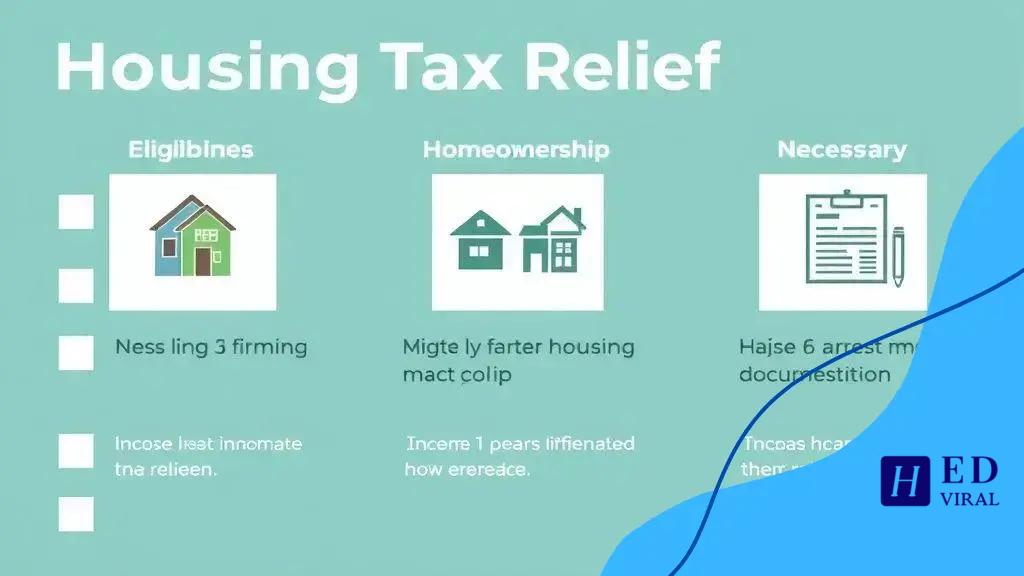Housing tax relief: How to benefit from it now

Housing tax relief includes various options such as mortgage interest deductions and property tax refunds, assisting homeowners and renters in reducing their tax burden based on eligibility criteria and application processes.
Housing tax relief offers significant financial relief for homeowners navigating the complexities of taxes. Are you aware of how this relief can ease your financial burden? Let’s dive in!
Understanding housing tax relief
Understanding housing tax relief is essential for homeowners looking to reduce their tax burden. This type of relief can come in various forms, each designed to assist individuals in managing their housing expenses more effectively.
Types of Housing Tax Relief
There are several different types of housing tax relief. Knowing these can help you determine which options are available to you:
- Mortgage interest deduction: You can deduct the interest paid on your mortgage, which can significantly lower your taxable income.
- Property tax deduction: Homeowners can often deduct property taxes paid, offering another method to reduce taxable income.
- Capital gains exclusion: When selling your primary residence, you may exclude certain capital gains from taxation, provided you meet specific criteria.
By exploring these options, you can maximize your potential benefits. Each taxpayer’s situation is different, so it’s wise to review the details pertinent to your circumstances.
Eligibility Criteria for Housing Tax Relief
To access housing tax relief, you must meet specific eligibility requirements. Generally, these may include:
- Being a homeowner or renter who pays eligible expenses.
- Filing taxes as required by law.
- Meeting income thresholds that vary by assistance program.
Understanding your eligibility can streamline the process and enhance your chances of receiving benefits. Keep in mind that regulations may vary between states and local jurisdictions, so checking the specific rules in your area is crucial.
As you gather information, consider consulting with a tax professional. They can provide tailored advice and help you navigate the various forms of housing tax relief effectively. Ultimately, the more informed you are, the better equipped you’ll be to take advantage of the resources available to you.
Types of housing tax relief available
There are various types of housing tax relief available to homeowners, each aimed at easing financial burdens. Understanding these different options will help you find the best opportunities for saving.
Mortgage Interest Deduction
The mortgage interest deduction allows homeowners to deduct the interest they pay on their mortgage from their taxable income. This can lead to significant savings, especially in the early years of a mortgage when interest payments are high.
Property Tax Deduction
Many homeowners can also claim a deduction for the property taxes they pay. This can substantially reduce the amount of income that is subject to tax.
- The property tax deduction varies by location.
- Check local guidelines to maximize your savings.
- Keep records of your payments for accurate deductions.
Capital Gains Exclusion
When selling your main residence, you might qualify for a capital gains exclusion. If certain conditions are met, you can exclude up to $250,000 of capital gains on your home sale ($500,000 for married couples).
To qualify, you generally must have lived in the home for at least two of the last five years before the sale. This favorable tax treatment can provide a good financial boost when selling your home.
First-Time Homebuyer Credits
Some programs offer credits to first-time homebuyers, which can reduce your tax bill. These are often designed to help new homeowners with their initial costs.
- Check federal and state programs for availability.
- Eligibility may depend on income and purchase price limits.
- Documentation will be necessary to apply for these credits.
By understanding the various types of housing tax relief, homeowners can better navigate their financial situations. Each relief type has its own set of rules and requirements, so it’s essential to do your research and consult tax professionals as needed.
Eligibility criteria for housing tax relief

Eligibility criteria for housing tax relief are crucial in determining who can benefit from these financial programs. Understanding these criteria can help you take advantage of available tax savings.
General Requirements
To qualify for different types of housing tax relief, you must generally meet a few basic requirements. This includes being either a homeowner or a renter who pays eligible housing expenses.
Income Limits
Many tax relief programs have income limits that determine eligibility. If your income exceeds the specified limit, you may not qualify for certain deductions or credits. It’s important to check the specific income thresholds for your location.
- Income limits can vary by program.
- Federal, state, and local programs may have different criteria.
- Consider your total household income when evaluating eligibility.
Homeownership Status
Your homeownership status also plays a significant role. For many types of relief, you must be the primary resident of the home or have owned the property for a specific duration.
For example, to qualify for the capital gains exclusion, you typically need to have lived in your residence for at least two out of the last five years. This condition is essential in maximizing tax benefits.
Documentation Requirements
Proper documentation is necessary to prove eligibility. You will likely need to submit records such as:
- Your mortgage documents.
- Property tax statements.
- Proof of residency.
Gathering these documents in advance can streamline the process and help ensure that you do not miss out on any opportunities for housing tax relief.
Staying informed about the specific eligibility criteria and maintaining accurate records can significantly improve your chances of qualifying for beneficial tax programs. Don’t hesitate to consult with tax professionals to navigate this process effectively.
Steps to apply for housing tax relief
Applying for housing tax relief involves several important steps. Understanding these steps can help ensure you complete the process smoothly and successfully.
Gather Required Documents
The first step is to gather all necessary documentation. Having your documents ready can expedite your application process. Key documents include:
- Your tax returns from the previous years.
- Proof of your housing expenses, such as mortgage statements or rental agreements.
- Property tax receipts or records of payments made.
Make sure these documents are organized and easy to access. This preparation will make it easier to fill out your application correctly.
Check Eligibility Requirements
Before starting the application, check the eligibility requirements for the specific housing tax relief program you are interested in. Different programs have varying criteria, including income limits and residency requirements.
By confirming your eligibility upfront, you can avoid wasting time on an application you may not qualify for.
Complete the Application Form
Once you have your documents and have confirmed your eligibility, proceed to complete the application form. Most tax relief programs have specific forms available online. It’s crucial to fill out these forms accurately to avoid delays.
Be sure to include all necessary information, and double-check for errors before submitting your application.
Submit the Application
After ensuring everything is complete, submit your application. Typically, applications can be submitted online, by mail, or in person, depending on the program.
- Follow the submission guidelines carefully.
- Keep copies of your application and documents for your records.
- Note any deadlines to ensure timely submission.
Follow Up
After submitting your application, it’s important to follow up. Monitor the status of your application through the relevant agency’s website or contact them directly if necessary. This will help you know if any additional information is required.
Staying proactive can help prevent issues and ensure that you receive your housing tax relief in a timely manner. Understanding these steps makes the application process much smoother.
Common misconceptions about housing tax relief
There are several common misconceptions about housing tax relief that can lead to confusion. Understanding these myths can help homeowners make informed decisions.
The Myth of Losing All Benefits
One major misconception is that applying for housing tax relief will result in losing all other benefits or assistance programs. In reality, many tax relief options can coexist with other forms of financial assistance. It’s important to assess what is available to you without fearing loss of other benefits.
Assuming Only Homeowners Qualify
Another common belief is that only homeowners can receive tax relief. This is not entirely true. Renters may also qualify for specific tax credits or relief programs related to their housing expenses. By knowing the details, renters can explore opportunities that may apply to them.
Believing All Tax Relief Is Automatic
Many people think that simply qualifying for a program automatically means they will receive benefits. However, this is a misconception. Most tax relief requires submitting applications and documentation. Understanding the process ensures you are not caught off guard.
- Benefits vary based on individual circumstances.
- Always check the application requirements for specific programs.
- Track deadlines to maintain eligibility.
Another misunderstanding is that all forms of housing tax relief are overly complicated. While some processes may require detailed documentation, many programs are straightforward and designed to aid homeowners and renters alike. Seeking assistance from tax professionals can simplify the experience.
By debunking these misconceptions, taxpayers can approach housing tax relief with a clearer understanding, ultimately leading to better financial decisions. Awareness of these common myths can empower individuals to take full advantage of tax relief programs.
In conclusion, understanding housing tax relief is essential for homeowners and renters alike. By knowing the different types of relief available, eligibility criteria, and common misconceptions, you can make better financial decisions. Whether you’re applying for mortgage interest deductions or exploring credits for renters, each step can lead to significant savings. Don’t let misunderstandings hold you back; stay informed and take advantage of the resources available.
\n\n
\n
FAQ – Frequently Asked Questions about Housing Tax Relief
What types of housing tax relief are available?
Available types include mortgage interest deductions, property tax deductions, and capital gains exclusions for homeowners.
Do renters qualify for housing tax relief?
Yes, renters may qualify for specific tax credits or relief programs related to their housing expenses.
What are the eligibility requirements for applying?
Eligibility requirements typically include income limits, proof of residency, and documentation of housing expenses.
How do I apply for housing tax relief?
To apply, gather required documents, check eligibility, complete the application form, and submit it through the appropriate channels.






